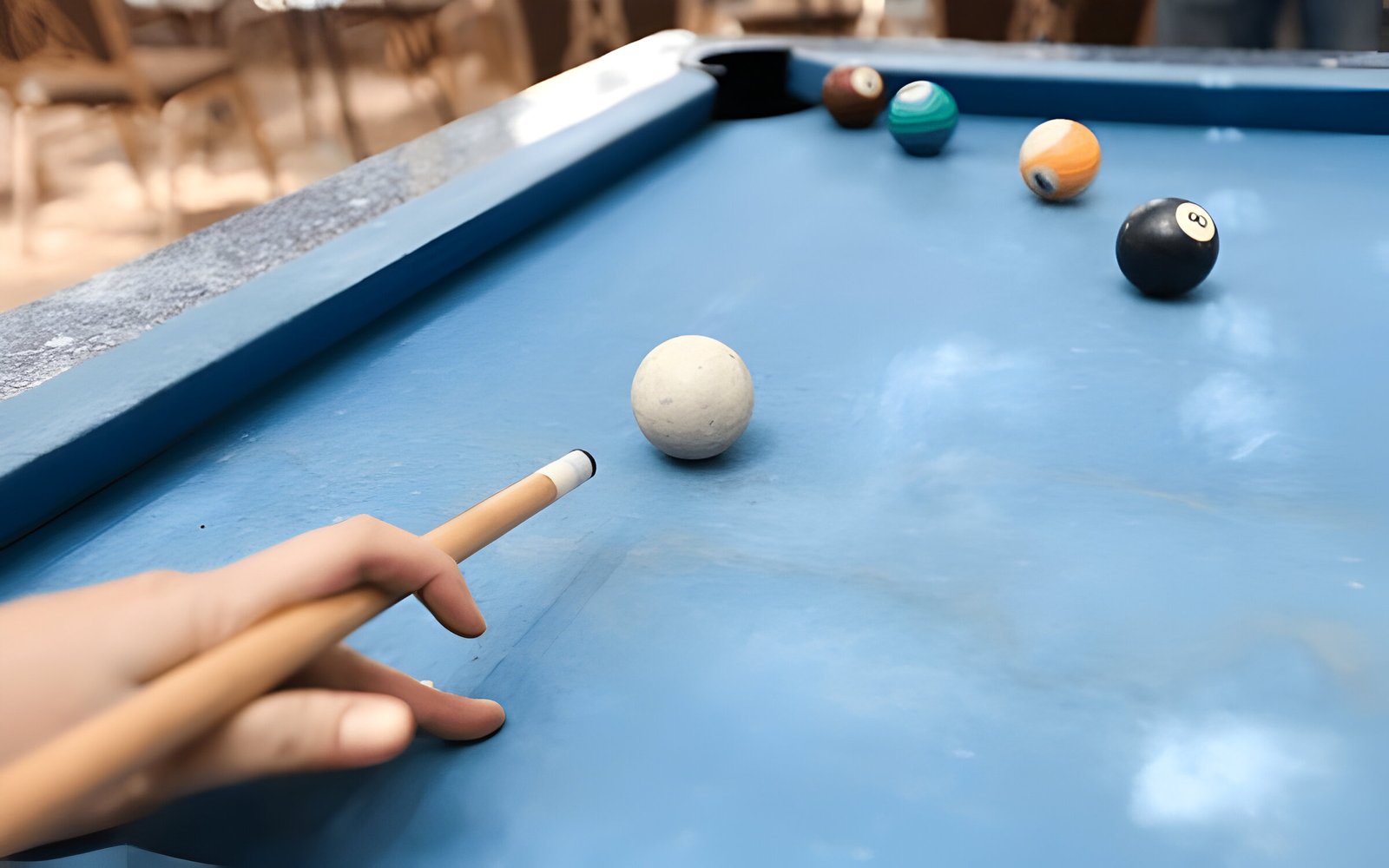Image Credits : Shutterstock
Pool table tricks have long captivated audiences, combining skill, precision, and showmanship. These impressive feats go beyond basic gameplay, showcasing the true potential of cue sports. From mastering the perfect spin to executing complex shots off multiple cushions, pool table tricks demonstrate the finesse and control that top players possess.
This article delves into the world of impressive pool table tricks, offering insights to enhance one’s game. Readers will learn about the jump shot, a technique to clear obstacles on the table. The article also explores the art of the masse shot, which uses extreme spin to curve the cue ball’s path. Additionally, it covers bank shots that utilize the rail to pocket balls with style. By practicing these techniques, players can improve their stance, grip, and timing, elevating their pool game to new heights.
Mastering the Jump Shot
The jump shot is an impressive pool table trick that allows players to overcome obstacles on the table. To execute this technique effectively, one needs to focus on proper equipment, technique, and belief in their abilities.
Proper Cue Grip and Stance
To perform a jump shot, players need to adjust their stance and grip. Instead of using a normal stance position, they should move everything forward as they elevate the cue. This helps in achieving the necessary cue elevation, especially for those who are not very tall. The grip should choke up on the cue, and the forearm should be in a vertical plane perpendicular to the cue.
For the bridge hand, it’s crucial to have it as high and stable as possible. Players should spread and flex their fingers slightly, raising and curling the thumb. If fingers are not very long, it can help to get more vertical on the index finger and turn the hand, using the other fingers for support.
Hitting Technique
The key to an effective jump shot lies in the hitting technique. Players should strike down on the cue ball, causing it to bounce off the table. It’s important to note that scooping under the ball is illegal and considered a foul.
When aiming, players should visualize an imaginary pearl at the center of the cue ball. The cue stick should point directly at, or slightly above or below, this imaginary point. For a “jump draw,” hitting slightly below the center is necessary, while a “jump follow” requires hitting just above the center.
The jump stroke should be executed with a relaxed grip and wrist, using a quick throwing motion. Players should not be afraid to accelerate into the cue ball as if trying to throw the cue into the table. The focus should be on a light, relaxed, smooth, and accelerating throwing motion rather than muscling the shot.
Practice Drills
To improve jump shot skills, players can try the following practice drills:
- Start with “baby jumps” where the goal is to clear a gap between two obstacle balls. Begin with a ball’s width gap and gradually narrow it, increasing cue elevation as needed.
- Use a pile of books or magazines to create practice “jump humps” on the table. Build humps of various heights and lengths to practice jumping over them.
- Practice “air strokes” to perfect the technique, focusing on a relaxed grip and wrist.
- Experiment with different cue elevations and speeds to understand how they affect the cue ball’s trajectory and landing point.
By consistently practicing these drills and focusing on proper technique, players can master the impressive jump shot and add it to their arsenal of pool table tricks.
The Art of the Masse Shot
The masse shot is a captivating technique in pool that allows players to curve the cue ball’s path, creating impressive and strategic plays. This advanced shot combines skill, precision, and an understanding of physics to overcome obstacles on the table.
Understanding Spin
The key to executing a masse shot lies in applying the right amount and direction of spin to the cue ball. Players need to hit the cue ball with an elevated cue, typically at an angle between 45 to 90 degrees, depending on the desired curve. The spin is achieved by striking the side of the cue ball in the direction of the intended curve.
To curve the cue ball to the left, players should aim for the 9 o’clock position on the ball. Conversely, to curve to the right, they should target the 3 o’clock position. The amount of spin applied has an influence on the severity of the curve, with more spin resulting in a tighter curve.
Cue Ball Positioning
Proper cue ball positioning is crucial for a successful masse shot. Players need to consider the following factors:
- Elevation: The cue should be raised to an angle between 45 to 90 degrees, depending on the desired curve.
- Contact point: Hit the cue ball on the side corresponding to the direction of the curve.
- Force: The amount of force applied has an impact on when the spin takes effect.
It’s important to note that softer hits cause the spin to take effect sooner, while harder hits allow the cue ball to travel further before curving.
Executing the Curve
To execute a masse shot effectively, follow these steps:
- Chalk up thoroughly to ensure proper grip on the cue ball.
- Position yourself for leverage, which may involve sitting on the rail or placing a leg on the table for better reach.
- Elevate the cue to the appropriate angle.
- Aim slightly past the first diamond to avoid hitting any obstacle balls.
- Apply a smooth, accelerating stroke, pushing through to the table surface.
Practice is essential to master this challenging shot. Start with smaller curves and gradually progress to more extreme angles as your skill improves. Remember to protect the table while practicing, as masse shots can potentially damage the felt if not executed properly.
By mastering the masse shot, players can add an impressive and strategic element to their pool game, allowing them to navigate around obstacles and create opportunities where none seemed to exist.
Impressive Bank Shots
Bank shots are a crucial skill in pool, allowing players to overcome obstacles and create opportunities where none seem to exist. These shots involve using the rail to pocket a ball, and mastering them can elevate a player’s game significantly.
Z-Bank Shot
The Z-bank shot is an advanced technique that uses English (spin) to manipulate the cue ball’s path after it hits the rail. This shot gets its name from the Z-shaped path the cue ball follows. To execute a Z-bank:
- Apply top spin to the cue ball for a standard Z.
- Use draw (backspin) to cut the angle on the last bank the most.
- Adjust the speed and spin to control the cue ball’s path.
It’s important to note that the shot must be hit hard enough to carry the English if trying to alter the path. Practice is key to mastering this impressive trick shot.
Backward Bank Shot
Also known as a reverse bank shot, this technique sends the object ball back in the direction it came from after hitting the rail. To perform a backward bank shot:
- Hit the cue ball with spin opposite to the desired direction of the object ball.
- The spin transfers to the object ball, causing it to reverse direction after hitting the rail.
- Adjust the angle and speed to control the object ball’s path.
This shot is particularly useful in bank pool or when a pocket is blocked. It’s a more controlled alternative to a heavy cut shot that might send the cue ball flying around the table.
Multiple Rail Banks
Multiple rail bank shots involve the object ball hitting two or more rails before pocketing. These shots require precise calculation and execution. To perform a multiple rail bank:
- Visualize the path of the object ball across multiple rails.
- Use the “angle in equals angle out” principle for each rail contact.
- Adjust for speed and spin, as these factors have an impact on the ball’s path.
For example, a three-rail bank might involve the object ball hitting three cushions before dropping into the pocket. These shots are not only impressive but can also be strategic when direct shots are not available.
Mastering these impressive bank shots requires consistent practice and a deep understanding of how spin, speed, and angles interact on the pool table. Players who can execute these shots reliably have a significant advantage in various game situations.
Conclusion
Pool table tricks offer a captivating blend of skill, precision, and showmanship that can take your game to new heights. By mastering techniques like the jump shot, masse shot, and impressive bank shots, players can overcome obstacles and create opportunities where none seemed to exist. These advanced moves not only showcase a player’s finesse and control but also have an impact on their strategic approach to the game.
To wrap up, the world of pool table tricks opens up exciting possibilities for players looking to enhance their skills and impress others. Whether it’s jumping over obstacles, curving the cue ball’s path, or executing complex bank shots, these techniques add depth and excitement to the game. With consistent practice and a deep understanding of the physics involved, players can transform their pool game from ordinary to extraordinary, leaving spectators in awe of their abilities.
FAQs
1. What strategies can I employ to enhance my pool playing skills?
To improve your pool skills, consider the following strategies:
- Refine your grip on the cue.
- Engage in specific billiard practice drills.
- Improve your bridge techniques.
- Identify and use your aiming lines effectively.
- Develop and consistently practice a shot routine.
- Train your arm to move like a pendulum.
- Maintain a proper posture throughout the game.
2. What are some effective tips to become a better billiards player?
To elevate your billiards game, try these tips:
- Adjust your grip for better control.
- Use a variety of bridge positions.
- Practice proper stance and body alignment.
- Choose the right pool cue for your style of play.
- Understand angles and consistently practice your swing and follow-through.
3. What are key techniques to master for better pool play?
Master these essential pool techniques to enhance your gameplay:
- Develop a loose grip on the cue.
- Work on your stance to ensure stability and accuracy.
- Focus on improving your aim.
- Practice swinging the cue smoothly.
- Learn different bridge techniques for various shots.
- Practice effective breaking techniques.
- Use pool chalk regularly to ensure better cue control.
- Always follow through after your shot for better precision.
4. How do professional players set up a pool table for a game?
Professionals follow specific racking rules to set up a pool table:
- Ensure the two rear corners of the triangle rack contain balls of different colors.
- Place two stripes of two balls each next to these corners.
- On the right side, arrange a stripe of three balls of the same color to connect with the two balls of the same color, forming a J-shape.




